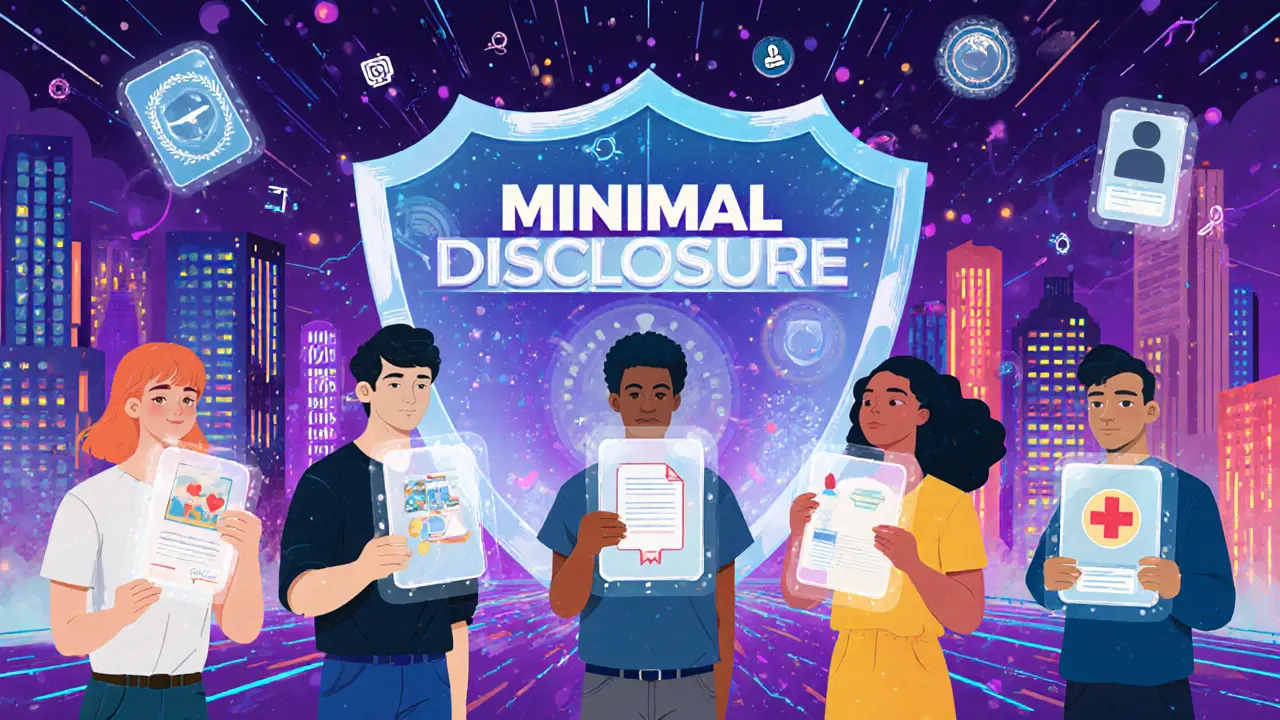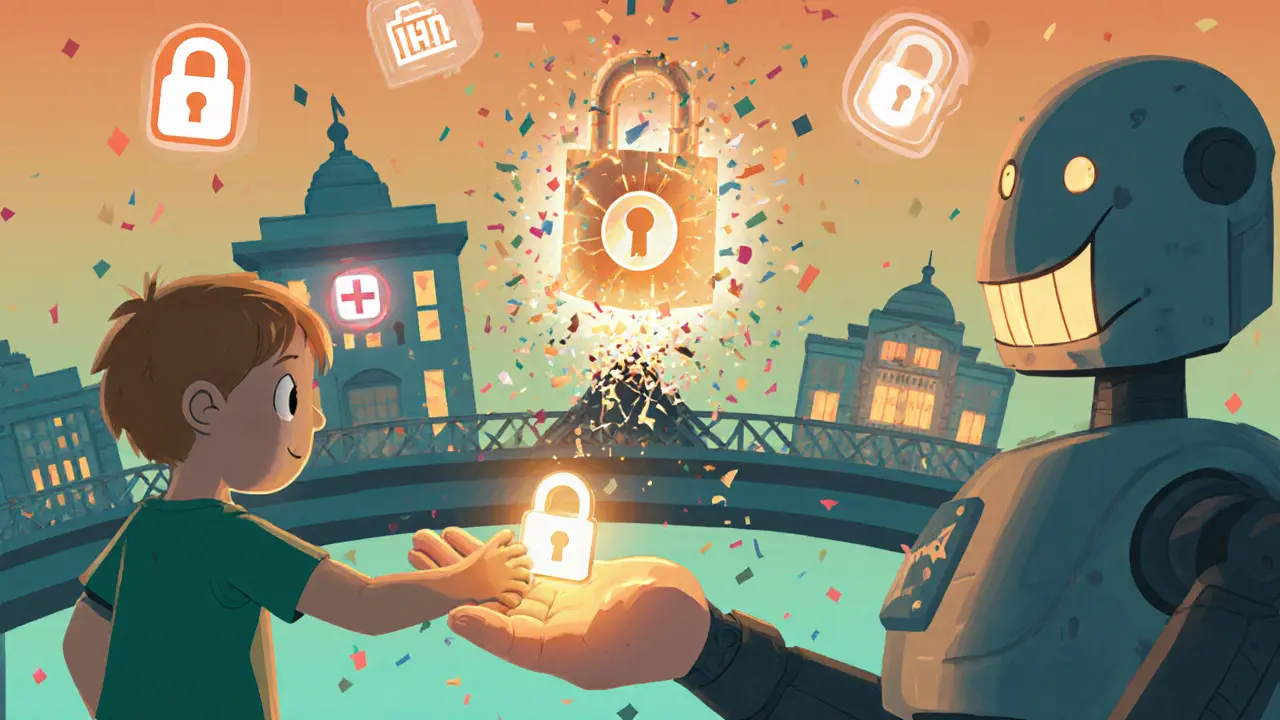 Oct, 28 2025
Oct, 28 2025
DID standards are changing how we prove who we are online-without relying on Google, Facebook, or any central company. Instead of logging in with an email or username, you use a cryptographic key you control. This is the core idea behind Decentralized Identifiers (DIDs). They’re not just another tech buzzword. They’re a formal, open standard from the World Wide Web Consortium (W3C), designed to give you full ownership of your digital identity.
What Exactly Is a DID?
A DID is a unique string of characters-like did:ethr:0x123... or did:ion:EiB...-that points to a public key and a set of rules for proving you own it. Unlike your Gmail address, which belongs to Google, a DID is generated by you. You don’t need permission. You don’t pay a fee. You don’t get locked out if a company shuts down.
The W3C DID Core v1.0 specification, published in 2022, defines DIDs as globally unique identifiers that let you prove control over them using digital signatures. That means if someone asks, "Are you the owner of this DID?"-you respond with a cryptographically signed message. No middleman. No database lookup. Just math.
How DID Protocols Work: The Layered System
DID protocols don’t exist in a vacuum. They’re built on top of well-known networking principles, much like how HTTP runs on TCP/IP. Think of them as a stack of rules, each handling a different part of the process:
- Resolution Layer: How you find the DID document (the file that describes the DID). This could be through a blockchain, a decentralized file system like IPFS, or even a traditional server.
- Verification Layer: How you prove you control the DID. This uses public-key cryptography-your private key signs a message, and anyone can verify it with your public key.
- Communication Layer: How you exchange data securely. This includes the
keyAgreementproperty, which lets two parties set up encrypted channels without sharing secrets upfront. - Metadata Layer: What the DID can do. It might say, "I can sign documents," or "I can receive encrypted messages," or "I’m verified by this government credential."
This layered structure means you can swap out parts without breaking everything. For example, you could use Ethereum to store your DID one day, and switch to a private database the next-without changing how you prove your identity.
Why DIDs Are Different From Traditional Logins
Right now, when you log into a website, you’re trusting them to keep your data safe. If they get hacked, your email, password, and maybe even your phone number are exposed. With DIDs, you never give your private data to anyone.
Let’s say you want to prove you’re over 18 to buy alcohol online. Instead of sending your driver’s license scan, you generate a verifiable credential signed by your government. You send only the proof: "This credential says I’m over 18. Here’s the signature. You can check it yourself." The website doesn’t see your name, address, or birthdate. Just the fact that you’re old enough.
This is called "minimal disclosure." And it’s built into the protocol. The W3C standard says you should be able to have as many DIDs as you need-one for work, one for shopping, one for activism. Each can be completely separate. No one can tie them together unless you choose to link them.

How DIDs Connect to Blockchains and Other Systems
DID standards are deliberately technology-agnostic. They don’t require blockchain. But many implementations use it because blockchains are tamper-proof, public, and decentralized-perfect for storing DID documents.
For example:
- did:ethr: Uses Ethereum to store DID records. Changes are confirmed by the network.
- did:ion: Built on Bitcoin’s blockchain via the InterPlanetary Naming System (IPNS). Low cost, high durability.
- did:web: Stores the DID document on a regular website. Simple, but relies on the site staying up.
You can even create a DID that references a traditional identity system-like a national ID number-without exposing it. The DID acts as a bridge. It says, "This is my government-issued ID, and here’s proof I control it." But the actual ID number stays hidden.
Security and Privacy Built In
DID protocols don’t just rely on encryption-they’re designed around it. The keyAgreement property lets you establish secure, end-to-end encrypted conversations. If you want to send a private message to someone, you don’t need to exchange passwords or keys beforehand. You use their public key, encrypted with their DID, and only they can decrypt it.
Compare this to email. Email uses TLS to encrypt the connection, but your provider still sees your messages. With DIDs, the message is encrypted at the application level. Even if someone intercepts it, they can’t read it. And you can prove you sent it.
There’s also built-in error handling. If a DID document can’t be found, the system can return a clear error-just like HTTP 404. If a signature is invalid, it’s rejected. No guesswork. No "your account might be compromised" popups.

Real-World Use Cases Already Happening
DIDs aren’t just theory. They’re being used today:
- Healthcare: Patients control access to their medical records. Doctors get verified, encrypted access only when needed.
- Education: Universities issue verifiable diplomas as DIDs. Employers check them instantly without calling the school.
- Supply Chain: A product’s origin, shipping history, and certifications are stored as DIDs. No more fake "organic" labels.
- Government: Estonia and New Zealand are testing DIDs for citizen services. You log into tax portals using your own key, not a password.
In New Zealand, a pilot project lets residents prove their residency status to banks using a DID linked to their IRD number-without revealing the number itself. That’s the power of minimal disclosure.
Challenges and Limitations
DIDs aren’t perfect. They’re still early-stage tech. Here’s what’s holding them back:
- Usability: Most people don’t know how to manage private keys. Losing your key means losing your identity. Wallets and recovery tools are improving, but they’re not mainstream yet.
- Adoption: Websites still prefer easy logins. Why make users install an app when they can just click "Sign in with Google"?
- Regulation: Governments aren’t sure how to handle digital identities they don’t control. Some are exploring it. Others are resisting.
But the momentum is growing. The W3C DID Working Group continues to refine the spec. Major companies like Microsoft, Sovrin, and the Linux Foundation are building tools. And developers are creating open-source libraries that make it easier to add DIDs to apps.
What Comes Next?
The next five years will see DIDs move from niche experiments to foundational infrastructure. We’ll likely see:
- Browsers with built-in DID wallets (like they have password managers now).
- Mobile apps that auto-generate DIDs when you sign up for a service.
- Regulatory frameworks that recognize DIDs as legally valid identity proof.
Eventually, you might not even notice you’re using a DID. You’ll just log in to your bank, your doctor, and your government portal-without typing a password. And you’ll know, for the first time, that no one else has access to your real identity.
Are DIDs the same as blockchain wallets?
No. A blockchain wallet (like MetaMask) holds crypto and signs transactions. A DID is a digital identity that can use a wallet to prove control, but it’s not limited to blockchains. You can have a DID that lives on a website, a database, or a private network. Wallets are one tool for managing DIDs-not the only one.
Can I lose my DID if I lose my private key?
Yes. If you lose your private key and don’t have a recovery method, you lose control of your DID. That’s why recovery protocols are critical. Some systems use multi-signature keys, social recovery (trusted friends help reset access), or hardware backups. Always set up recovery before relying on a DID for anything important.
Do I need to pay to use DIDs?
Most DIDs are free to create. But some methods, like those using Ethereum or Bitcoin, may have small transaction fees (called gas fees) to register or update the DID. Other methods, like did:web or did:ion, are often free. There are no subscription fees built into the standard.
Are DIDs secure against quantum computing?
Current DIDs use standard cryptographic algorithms like Ed25519, which are not quantum-resistant. But the W3C spec allows for algorithm upgrades. Future DIDs will likely switch to post-quantum cryptography (like CRYSTALS-Kyber) when it becomes standardized. The system is designed to evolve, not lock you in.
Can governments track me using DIDs?
Only if you choose to link your DID to something they can track. DIDs are anonymous by default. You can create thousands of them. You can use one for your job, another for your hobbies, and never connect them. The system is designed to protect privacy-not enable surveillance. Governments can’t force you to use a DID they control.
Ron Murphy
October 29, 2025 AT 14:15DID resolution layers are fascinating because they decouple identity from infrastructure. You can host your DID doc on IPFS, Ethereum, or even a static web server-same semantics, different backends. The W3C spec’s agnosticism here is genius. No vendor lock-in. No single point of failure. Just pure cryptographic ownership.
That said, the UX still sucks. Most people don’t know what a private key is, let alone how to back it up. We need abstracted wallets that feel like password managers, not crypto terminals.
Prateek Kumar Mondal
October 30, 2025 AT 14:56DID is the future no doubt. No more passwords. No more data leaks. Just you and your key. Simple. Clean. Powerful. The world needs this.
Nick Cooney
November 1, 2025 AT 09:32Oh wow. Another ‘decentralized identity’ whitepaper dressed up like a revelation. Let me guess-next you’ll tell me blockchain will solve climate change?
Look, I get the math. But the real world runs on Google and Facebook. People don’t want to manage keys. They want to click ‘Sign in with Apple’ and forget about it. This isn’t progress. It’s a solution in search of a problem that doesn’t exist for 99% of users.
Also-did:ion uses Bitcoin? Nope. It uses IPNS on IPFS. Bitcoin’s just a timestamping layer. Fix your tech blog, please.
Wayne Overton
November 1, 2025 AT 12:30So you’re telling me I have to carry a key like a goddamn USB stick now? Great. Just what I needed. Another thing to lose. Another thing to forget. Another thing to get hacked. This is worse than passwords.
Alisa Rosner
November 3, 2025 AT 01:29OMG this is SO COOL!!! 🤩 I just created my first DID using a free app and now I can prove I'm a human without giving my birthdate to every sketchy site!! 🎉 It's like magic but real!! 🧙♀️✨ You guys NEED to try this!! It's so empowering!!
MICHELLE SANTOYO
November 4, 2025 AT 07:22They say DIDs give you control-but who really controls the standards? The W3C? Who funds them? Who writes the specs? It’s still a gated club of corporations with fancy titles. This isn’t decentralization. It’s rebranding centralization with crypto jargon.
And don’t get me started on ‘minimal disclosure.’ If you can prove you’re over 18, why not prove you’re a citizen? A voter? A taxpayer? Soon they’ll require DIDs just to buy milk. Welcome to the digital panopticon. They just made it prettier.
Herbert Ruiz
November 5, 2025 AT 02:33Incorrect. The W3C DID Core specification is v1.1, not v1.0. Also, did:ion does not run on Bitcoin’s blockchain. It runs on the Bitcoin blockchain via the ION protocol, which uses Bitcoin for anchoring but not for storage. Please update your terminology.
Saurav Deshpande
November 5, 2025 AT 16:48They want you to believe DIDs are about freedom. But who built the first DID registries? Microsoft. Google. The same entities that track you now. This is a Trojan horse. They’re building a new system where you think you’re free, but they still hold the keys-just encrypted.
And don’t tell me about ‘minimal disclosure.’ If you use a DID linked to your government ID, you’re already compromised. This is surveillance with a smiley face.
Paul Lyman
November 5, 2025 AT 22:58Guys. This is huge. Seriously. I just helped my mom set up a DID for her medical records. She’s 72. She thought it was too hard. But we used a simple app-no keys to copy. Just a PIN and a voice backup. She’s now controlling who sees her prescriptions.
Stop talking about tech. Start talking about people. This isn’t about blockchain. It’s about dignity. You can do this. I believe in you. Let’s build this together. 💪
Frech Patz
November 7, 2025 AT 09:07Can you clarify the distinction between the keyAgreement property and the authentication property in the DID document? The specification implies they are orthogonal, but practical implementations often conflate them. Is this intentional?
Derajanique Mckinney
November 9, 2025 AT 00:23so like… you’re saying i dont need passwords anymore?? but i still have to do like… crypto stuff?? bruh. i just wanna scroll tiktok and not think about keys. also did:web is just a website? lol. what if the site goes down? then my identity is gone?? 😭
Sunny Kashyap
November 10, 2025 AT 03:41India already has Aadhaar. Why do we need another system? This is Western tech arrogance. We don’t need your blockchain identities. We have a national ID that works for 1.4 billion people. Stop exporting your problems as solutions.
Anna Mitchell
November 11, 2025 AT 15:51This is actually really exciting. I’ve been worried about data leaks since the Equifax breach. The idea that I can prove something about myself without giving away everything? That’s peace of mind. I hope more services adopt this soon.